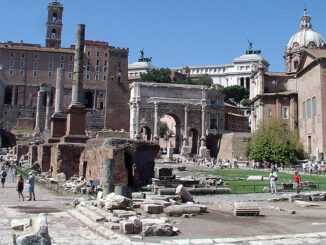SIENA, Italy — Sitting at the peak of a hill in the heart of this Tuscan city, Siena Cathedral just looks divine. The house of worship towers above the rolling Tuscan landscape around it as if to beckon visitors.
Built between 1215 and 1263, the cathedral is considered by many to be Italy’s greatest cathedral and among the most beautiful in Europe. Talking about Siena Cathedral would be difficult without commenting on its sheer massiveness. The church – an example of Romanesque architecture – was to be the largest cathedral ever built. What more remarkable is that what stands today is only a fraction of what was planned over the years.
Looking skyward at the black and white marble façade of the bell tower, it’s hard not to be awestruck at the church’s beauty. More than just a unique design, the creators selected black (or greenish) and white marble to match the city’s official colors – symbolic links to the black and white horses of Senius and Aschius, Siena’s founders. Symbolism is everywhere in the church, and outside is another symbol of the city, a she-wolf statue sitting atop a column. According to legend, Senius’ father Remus and his twin brother Romulus, who co-founded Rome together, were raised by a wolf.
The chapel’s hexagon-shaped dome, constructed between 1259 and 1264 features a lantern added by Giovanni Lorenzo Bernini, top Baroque sculptor, and its façade, which wasn’t finished until 1380, also features a number of statues depicting philosophers, prophets and apostles. For better or worse, most of the sculptures on display today are copies, as the originals have been removed for safe keeping.
In 1339, the church planned to double the size of the Siena Cathedral to highlight the wealth of Siena at the time. Although the addition was never finished – in part because of the Black Death in 1348 – evidence in the form of outer walls for the would-be expansion is still visible today.
It’s hard to imagine just how large Siena Cathedral would have been had the church been expanded in the 14th century. Even though the church’s expansion was never realized, the cathedral in its current incarnation is spectacular and a testament to the city’s wealth and grandeur.
The inside of the cathedral is just as ornate and majestic as the exterior, with black and white marble walls and matching columns supporting the church’s soaring ceiling. The church’s octagonal pulpit, carved between 1265 and 1268, features carvings depicting seven scenes that narrate the Life of Christ from His birth to His crucifixion. Nicola Pisano, sometimes credited as the “founder of modern sculpture,” carved the pulpit using marble from the Tuscan city of Carrara.
Every aspect of the church is elaborate, and its floor is no exception. The cathedral’s inlaid marble mosaic floor is said to be among the most intricate in the country. Unfortunately it is covered for most of the year.
And, the church’s art collection is as impressive as the building itself, keeping up with the notation that Siena is a city known for its art. The church’s collection includes works from some of the finest artisans that Italy has ever produced, including Donatello, Bernini and Michelangelo.




